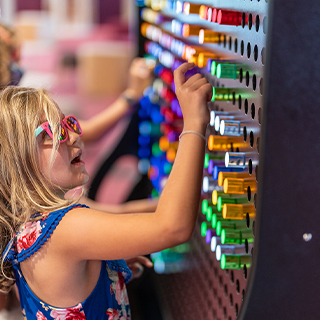Wildfire Field Trips
spectrUM is committed to supporting the next generation of scientists and innovators by engaging students in hands-on science. The exhibits and activities featured in our field trips are curated to inspire a culture of learning and discovery and are facilitated by trained educators who serve as role models by demonstrating a passion for science and pathways to higher education.
Field trips are designed to give students the opportunity to explore our museum independently to make their own discoveries, as well as work with our educators to learn science concepts through guided experiments and activities. While each field trip topic explores different themes, students and educators will model the scientific method and are encouraged to be curious learners. Field trip curricula are designed to meet NGSS, but may be adapted to all ages and abilities.
Essential Question
What causes wildfires and how does it impact plants, animals and people?
Objectives
Students will identify different wildfires.
Students will understand the causes and effects of wildfires.
Students will learn the chemistry of fire using the Fire Triangle.
Available Activities
Measuring Flame Plumes
Crafting and testing the fire triangle
Storytelling
Designing and testing wildfire prototypes
Identifying the impacts of wildfires on trees
Supporting Assessments
Formative: Educators and students will refer to terms and concepts involving the science of wildfires, natural hazards, weather, and climate.
Summative: Students will lead discussion using terms and science concepts to demonstrate understanding throughout activities.
Available Generation Science Standards
Are you looking to support a science standard in your classroom? Let us know and we can tailor your field trip to the needs of your students.
K-2
- Some kinds of severe weather are more likely than others in a given region. Weather scientists forecast severe weather so that the communities can prepare for and respond to these events. (K-ESS3-2)
- Asking questions, making observations, and gathering information are helpful in thinking about problems. (secondary to K-ESS3-2)
- Events have causes that generate observable patterns. (K-ESS3-2), (K-PS3-1), (K-PS3-2)
- Ask questions based on observations to find more information about the designed world. (K-ESS3-2)
- Make observations (firsthand or from media) to collect data that can be used to make comparisons. (K-PS3-1)
- Scientists look for patterns and order when making observations about the world. (K-ESS2-1)
- Scientists use different ways to study the world. (K-PS3-1)
- Systems in the natural and designed world have parts that work together. (K-ESS2-2), (K-ESS3-1)
- Use a model to represent relationships in the natural world. (K-ESS3-1)
- Heating or cooling a substance may cause changes that can be observed. Sometimes these changes are reversible, and sometimes they are not. (2-PS1-4)
- Simple tests can be designed to gather evidence to support or refute student ideas about causes. (2-PS1-2)
3rd-5th grade
- When the environment changes in ways that affect a place’s physical characteristics, temperature, or availability of resources, some organisms survive and reproduce, others move to new locations, yet others move into the transformed environment, and some die. (secondary to 3-LS4-4)
- Cause and effect relationships are routinely identified and used to explain change. (3-LS2-1), (3-LS4-3)
- Analyze and interpret data to make sense of phenomena using logical reasoning. (3-LS4-1)
- A variety of natural hazards result from natural processes. Humans cannot eliminate natural hazards but can take steps to reduce their impacts. (3-ESS3-1) (Note: This Disciplinary Core Idea is also addressed by 4-ESSS3-2.)
- Make observations and/or measurements to produce data to serve as the basis for evidence for an explanation of a phenomenon. (4-ESS2-1)
- Identify the evidence that supports particular points in an explanation. (4-ESS1-1)
Middle School
- Cause and effect relationships may be used to predict phenomena in natural or designed systems. (MS-ESS3-1)
- Develop and use a model to describe phenomena. (MS-ESS2-1)
- Models can be used to represent systems and their interactions—such as inputs, processes and outputs—and energy, matter, and information flows within systems. (MS-ESS2-6)
- Ask questions to identify and clarify evidence of an argument. (MS-ESS3-5)
- Develop and use a model to describe phenomena. (MS-ESS2-6)
